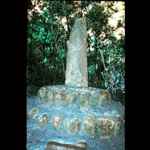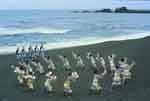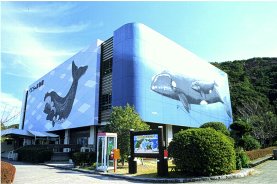Tomyozaki Cape
 This used to
be the general headquarters, where about twenty of the Yamamigata,
hereditary whale watchers, took turns to reside. The role of the Yamamigata
were to find whales, to distinguish their kinds, to signal boats to start,
to keep track of their positions, to decide where to whale according to the
situation of the tidal current, and to give instructions on the whaling
operation in general. The system of whaling was integrally related to the
everyday life of the local community in Taiji.
This used to
be the general headquarters, where about twenty of the Yamamigata,
hereditary whale watchers, took turns to reside. The role of the Yamamigata
were to find whales, to distinguish their kinds, to signal boats to start,
to keep track of their positions, to decide where to whale according to the
situation of the tidal current, and to give instructions on the whaling
operation in general. The system of whaling was integrally related to the
everyday life of the local community in Taiji. The Stone Monument of Kibino Makibi
 This
monument was built for Kibino Makibi who was sent to Tang (China) as a
vice-ambassador. He was washed ashore after being shipwrecked by a storm at
this cape when it was called Muronomisaki(Muro cape) in the Era of Emperor
Koken (753 A.D.). Muronomisaki was the first name of this cape later to be
changed to Taijisaki. It is now called Tomyozaki.
This
monument was built for Kibino Makibi who was sent to Tang (China) as a
vice-ambassador. He was washed ashore after being shipwrecked by a storm at
this cape when it was called Muronomisaki(Muro cape) in the Era of Emperor
Koken (753 A.D.). Muronomisaki was the first name of this cape later to be
changed to Taijisaki. It is now called Tomyozaki. The Yamami/Lighthouse
 This
Yamami (lookout/lighthouse) was the place where watchmen
looked out to sea in search of whales they migrated
through the 'path of whales' off the coast of Taiji.
At one time in ruins, the site has now been recently
restored. The first lighthouse in Japan which used whale
oil for its lantern was built here on October 3 in 1636.
Its foundation stone still remains here. This lighthouse
was restored according to information acquired from
ancient records. This place was also used for
communicating with ships at sea by lighting signal fires
and putting up flags. Once caught, whales were completely
utilized leaving no waste; its meat for food, its bones
for tools and crafts, its oil for lanterns, etc.
This
Yamami (lookout/lighthouse) was the place where watchmen
looked out to sea in search of whales they migrated
through the 'path of whales' off the coast of Taiji.
At one time in ruins, the site has now been recently
restored. The first lighthouse in Japan which used whale
oil for its lantern was built here on October 3 in 1636.
Its foundation stone still remains here. This lighthouse
was restored according to information acquired from
ancient records. This place was also used for
communicating with ships at sea by lighting signal fires
and putting up flags. Once caught, whales were completely
utilized leaving no waste; its meat for food, its bones
for tools and crafts, its oil for lanterns, etc. Kujirakata Hyoryunin Kinenhi
 This
monument was constructed to commemorate a group of
whalers who got shipwrecked after whaling for a mother
whale and a baby whale. This was in violation of the
traditional teaching to never go after a whale with a
baby. This was one taboo handed down by word of mouth
among whalers: 'Never touch a humpback whale when with
its baby.' People were suffering from a bad catch and
famine that year, and were waiting to see a signal from
the yamami (watchman). When it finally came, it was
pointing to a mother whale and a baby. The whalers
decided to whale in violation of the taboo and in spite
of the bad weather. They never to returned. They built
this monument as a warning to hand down to their
descendants.
This
monument was constructed to commemorate a group of
whalers who got shipwrecked after whaling for a mother
whale and a baby whale. This was in violation of the
traditional teaching to never go after a whale with a
baby. This was one taboo handed down by word of mouth
among whalers: 'Never touch a humpback whale when with
its baby.' People were suffering from a bad catch and
famine that year, and were waiting to see a signal from
the yamami (watchman). When it finally came, it was
pointing to a mother whale and a baby. The whalers
decided to whale in violation of the taboo and in spite
of the bad weather. They never to returned. They built
this monument as a warning to hand down to their
descendants. to the top
Hogeizu
 This
picture of the Taiji whaling fleet is owned by the Whale
Museum in Taiji Town. Whaling has similarities to war at
sea. It is perhaps through whaling that the old Kumano
Navy became so strong. The technique, strategies and
organized force of whaling naturally would prove useful
in real battle as well. In ancient times whalers used to
catch whales which came close to the coast by using a bow
and arrow. Later, Kakuemon of the Wada family, who was
the chief of Kumano Navy, improved the whaling technique
with the 'Tsukitori ho' (stabbing method) which used
harpoons in a group called 'Sashite gumi' (harpooner
group). Later in 1675, he also contrived the 'amitori ho'
(net method) where the net first catches a whales head
after which a harpoon was used. This method spread
swiftly all over Japan as the 'Taiji Whaling Method'.
This picture, displayed in the Whale Museum, depicts a
traditional whaling expedition in progress.
This
picture of the Taiji whaling fleet is owned by the Whale
Museum in Taiji Town. Whaling has similarities to war at
sea. It is perhaps through whaling that the old Kumano
Navy became so strong. The technique, strategies and
organized force of whaling naturally would prove useful
in real battle as well. In ancient times whalers used to
catch whales which came close to the coast by using a bow
and arrow. Later, Kakuemon of the Wada family, who was
the chief of Kumano Navy, improved the whaling technique
with the 'Tsukitori ho' (stabbing method) which used
harpoons in a group called 'Sashite gumi' (harpooner
group). Later in 1675, he also contrived the 'amitori ho'
(net method) where the net first catches a whales head
after which a harpoon was used. This method spread
swiftly all over Japan as the 'Taiji Whaling Method'.
This picture, displayed in the Whale Museum, depicts a
traditional whaling expedition in progress. to the top
Kujira Odori
 Kujira
Odori (whale dance) is a traditional performing art
preserved in Miwasaki ward in Shingu City. This precious
cultural tradition tells of the history of the local
traditional whaling culture. The dance was created some
300 years ago as a way to show how the whalers challenged
whales with only simple fishing tools and boats that they
rowed out to sea. The 'Denchu odori' (Denchu dance) shows
how they would cast their net and surround the whales,
and 'aya odori' shows how they caught the whales using
their harpoons. This dance has been designated as an
intangible cultural treasure by the prefecture as well as the
city government. This dance is held during the Miwasaki
Hachiman Shrine Festival in September and attracts a
large number of tourists.
Kujira
Odori (whale dance) is a traditional performing art
preserved in Miwasaki ward in Shingu City. This precious
cultural tradition tells of the history of the local
traditional whaling culture. The dance was created some
300 years ago as a way to show how the whalers challenged
whales with only simple fishing tools and boats that they
rowed out to sea. The 'Denchu odori' (Denchu dance) shows
how they would cast their net and surround the whales,
and 'aya odori' shows how they caught the whales using
their harpoons. This dance has been designated as an
intangible cultural treasure by the prefecture as well as the
city government. This dance is held during the Miwasaki
Hachiman Shrine Festival in September and attracts a
large number of tourists. to the top
The Tools of Traditional Whaling
 The photo here shows three harpoon heads used by
local whalers. The larger harpoons are about 1metre in length
and weigh more than 2kilograms.
The photo here shows three harpoon heads used by
local whalers. The larger harpoons are about 1metre in length
and weigh more than 2kilograms.  Instead of throwing the harpoons directly at
the whales, they were thrown high into the sky so that
they would fall vertically in order to stab deeply into
the whale's back. After the whale was harpooned, the rope
attached to the harpoon was pulled to bend the handle so
that the harpoon would not come out easily. The handle
was therefore specially made to bend easily.
Instead of throwing the harpoons directly at
the whales, they were thrown high into the sky so that
they would fall vertically in order to stab deeply into
the whale's back. After the whale was harpooned, the rope
attached to the harpoon was pulled to bend the handle so
that the harpoon would not come out easily. The handle
was therefore specially made to bend easily.
to the top
Nigishima Memorial
 A whale memorial stands quietly at the foot of
the Sengen Shrine in Nigishima. This was built long ago
as an expression of compassion and gratitude towards
nature. Kumano is considered the area where whaling in
Japan originated. In Nigishima a whaling treaty called
'kujirabune sadame' is preserved which is believed to
have been a treaty between various groups of whalers
called kujirakata who hailed from places like Nigishima,
Yuki, Isozaki, and Kinomoto in Kumano City.
A whale memorial stands quietly at the foot of
the Sengen Shrine in Nigishima. This was built long ago
as an expression of compassion and gratitude towards
nature. Kumano is considered the area where whaling in
Japan originated. In Nigishima a whaling treaty called
'kujirabune sadame' is preserved which is believed to
have been a treaty between various groups of whalers
called kujirakata who hailed from places like Nigishima,
Yuki, Isozaki, and Kinomoto in Kumano City. to the top
Whale Museum
 As an attempt to foster international
understanding of the local whaling culture, Taiji Town
built this museum in 1969 when whaling began to be
criticized around the world. This museum is full of
whaling artifacts and is also a research facility for
studying whales and their habits. After 21 years of
voyages to the Antarctic Ocean the whaling ship 'Kiyomaru
#11' can be viewed as a museum artifact and is situated
just outside the whale museum. A plan to establish an
international whale research institute is now under way
at the moment.
As an attempt to foster international
understanding of the local whaling culture, Taiji Town
built this museum in 1969 when whaling began to be
criticized around the world. This museum is full of
whaling artifacts and is also a research facility for
studying whales and their habits. After 21 years of
voyages to the Antarctic Ocean the whaling ship 'Kiyomaru
#11' can be viewed as a museum artifact and is situated
just outside the whale museum. A plan to establish an
international whale research institute is now under way
at the moment. to the top